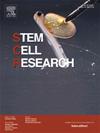Generation of footprint-free human induced pluripotent stem cell line (SCIKFi001-B) from cGMP grade umbilical cord-derived mesenchymal stem cells (UC-MSCs) using episomal-plasmid based reprogramming approach
IF 0.8
4区 医学
Q4 BIOTECHNOLOGY & APPLIED MICROBIOLOGY
引用次数: 0
Abstract
UCMSCs were reprogrammed to iPSCs using Yamanaka factor bearing episomal plasmids. SCIKFi001-B exhibited pluripotency, had typical iPSC morphology and didn’t retain any residual episomal plasmid. Although karyotyping showed chromosomal translocation, this abnormality seemed to have little impact on the functionality of SCIKFi001-B since it retained its ability to differentiate to three-germ layer. While karyotypic abnormality might negate use in therapeutic and clinical settings, this line remained a valuable educational tool for iPS cell culture techniques. Finally, our study highlighted the importance of routine karyotyping on iPSC lines as abnormal karyotypes oftentimes bear no discernible effect on cell morphology nor functionality.
利用基于外显子体-质粒的重编程方法,从 cGMP 级脐带间充质干细胞 (UC-MSCs) 中生成无足迹人诱导多能干细胞系 (SCIKFi001-B)
使用含有表观质粒的山中因子将 UCMSCs 重编程为 iPSCs。SCIKFi001-B表现出全能性,具有典型的iPSC形态,并且没有保留任何残留的表型质粒。虽然核型检查显示染色体易位,但这种异常似乎对 SCIKFi001-B 的功能影响不大,因为它仍能分化到三胚层。虽然核型异常可能会影响其在治疗和临床环境中的应用,但该品系仍然是 iPS 细胞培养技术的重要教育工具。最后,我们的研究强调了对 iPSC 株系进行常规核型分析的重要性,因为核型异常通常不会对细胞形态或功能产生明显影响。
本文章由计算机程序翻译,如有差异,请以英文原文为准。
求助全文
约1分钟内获得全文
求助全文
来源期刊

Stem cell research
生物-生物工程与应用微生物
CiteScore
2.20
自引率
8.30%
发文量
338
审稿时长
55 days
期刊介绍:
Stem Cell Research is dedicated to publishing high-quality manuscripts focusing on the biology and applications of stem cell research. Submissions to Stem Cell Research, may cover all aspects of stem cells, including embryonic stem cells, tissue-specific stem cells, cancer stem cells, developmental studies, stem cell genomes, and translational research. Stem Cell Research publishes 6 issues a year.
 求助内容:
求助内容: 应助结果提醒方式:
应助结果提醒方式:


